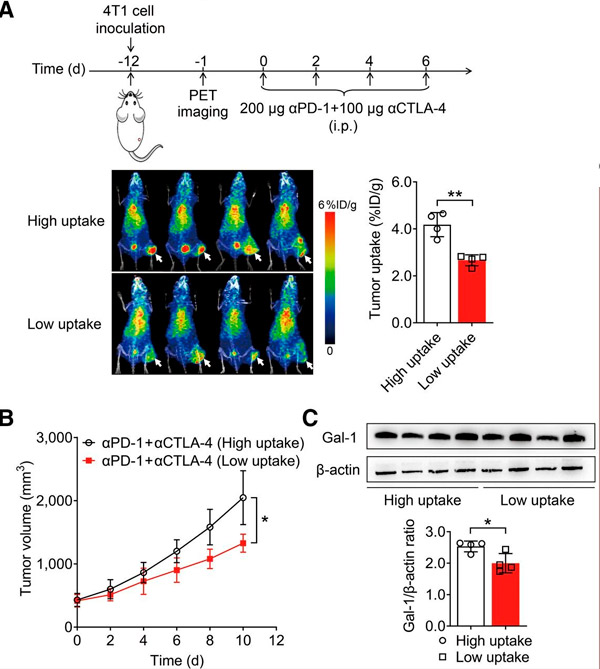New publications
New biomarker allows doctors to predict tumor response before treatment begins
Last reviewed: 02.07.2025

All iLive content is medically reviewed or fact checked to ensure as much factual accuracy as possible.
We have strict sourcing guidelines and only link to reputable media sites, academic research institutions and, whenever possible, medically peer reviewed studies. Note that the numbers in parentheses ([1], [2], etc.) are clickable links to these studies.
If you feel that any of our content is inaccurate, out-of-date, or otherwise questionable, please select it and press Ctrl + Enter.

The protein galectin-1 (Gal-1) has been identified as a new biomarker for PET imaging used in immunotherapy with checkpoint blockade (ICB), allowing physicians to predict tumor response before treatment.
Information obtained from Gal-1 PET imaging could also be used to stratify patients and optimize immunotherapy, allowing for targeted interventions and improved patient outcomes. The study was published in the May issue of The Journal of Nuclear Medicine.
Immunotherapies such as ICB have shown encouraging clinical results in melanoma, non-small cell lung cancer, and several other tumor types. However, only a subset of patients experience positive results, with objective response rates ranging from 5% to 60%.
"Developing reliable approaches to assess responses and select appropriate patients for immunotherapy remains challenging," said Zhaofei Liu, PhD, a distinguished professor at Peking University in China.
"Current clinical criteria for monitoring responses to immunotherapy in solid tumors are based on CT and MRI, but these methods result in a significant delay between the start of treatment and the assessment of response. Molecular imaging techniques, especially PET, have emerged as reliable tools for predicting the efficacy of immunotherapy through quantitative and noninvasive assessment of biomarkers in real time."

124I-αGal-1 PET scanning predicts the efficacy of immune checkpoint inhibitor (ICB) therapy. Source: N Liu and X Yang et al., Peking University, Beijing, China.
The study used a mouse model to identify new imaging biomarkers for tumor responses to ICB therapy. Using proteomic analysis (separating, identifying, and quantifying proteins in the tumor), the researchers found that tumors with low Gal-1 expression responded positively to ICB therapy.
Gal-1 was then labeled with 124I and the radiotracer (124I-α-Gal-1) was used in small animal PET imaging and distribution studies to evaluate the specificity of the radiotracer. PET imaging with 124I-αGal-1 revealed the immunosuppressive status of the tumor microenvironment, which allowed the prediction of resistance to ICB therapy before treatment.
For tumors that were not predicted to respond well to ICB therapy, the researchers developed a salvage strategy using a Gal-1 inhibitor that significantly improved the chances of success.
"Gal-1 PET opens the possibility of early prediction of ICB efficacy before treatment and facilitates precise design of combination regimens," Liu noted. "This sensitive approach has the potential to achieve individualized precision treatment for patients in the future."
